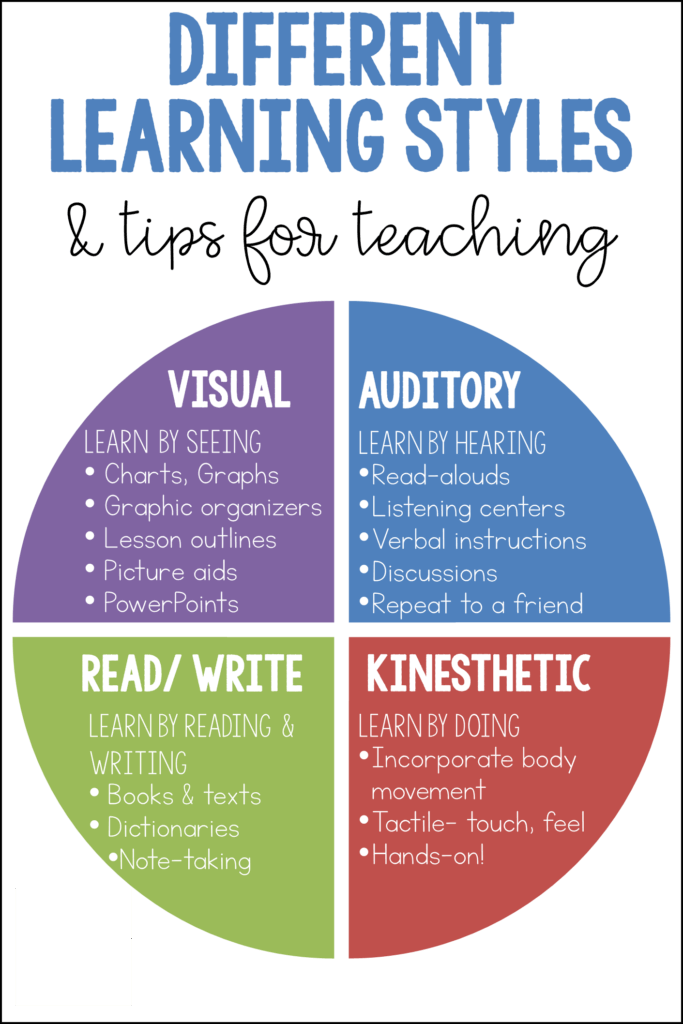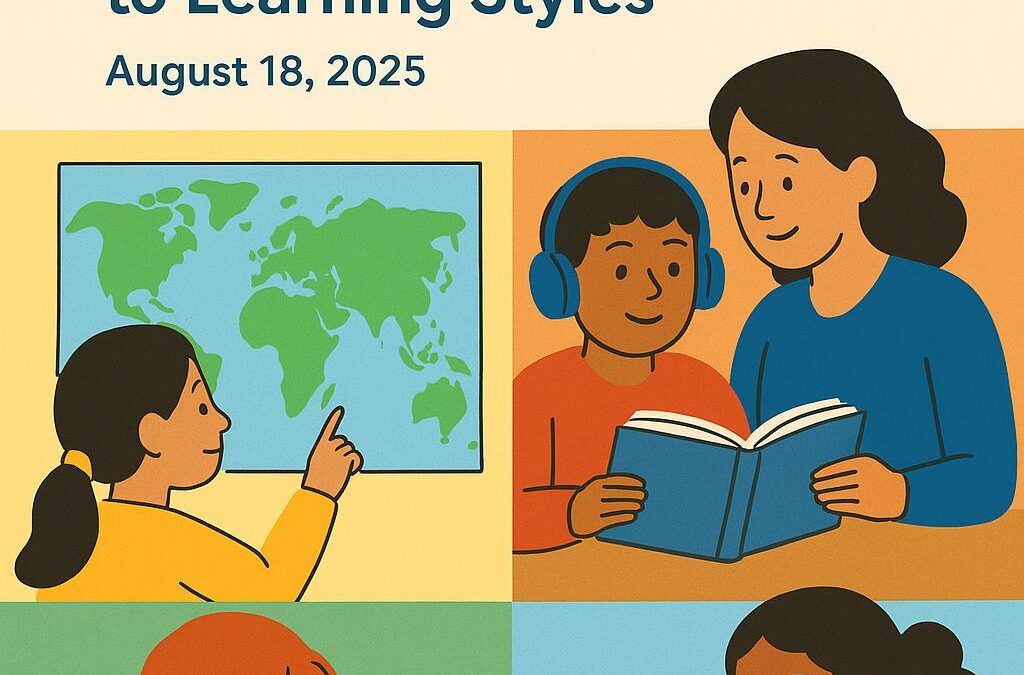August 18, 2025
Ever feel like you’re explaining a concept for the tenth time, and it’s just not clicking? You’ve tried diagrams, you’ve tried lectures, you’ve tried reading from the textbook, but you’re met with a blank stare. If this sounds familiar, you’re not alone. The solution might not be to explain it louder or slower, but to explain it differently.
Welcome to the world of learning styles! The simple truth is that every child absorbs and processes information in their own unique way. As a homeschooling parent, you have the incredible advantage of tailoring your child’s education to fit them perfectly. Understanding their learning style is the key that unlocks a more effective, engaging, and joyful learning experience for everyone.
Let’s explore the most common framework, VARK, and discover how you can turn this knowledge into your homeschooling superpower.
What Are Learning Styles? The VARK Model Explained
The VARK model categorizes learners into four main types. While most people are a blend, they often have one or two dominant styles that feel most natural. (Image curtosey on sherpa-online)

1. Visual (Spatial) Learners
These learners need to see it to believe it. They think in pictures and learn best from visual displays, including diagrams, charts, videos, and colorful illustrations.
You might have a Visual Learner if your child:
- Is an avid doodler during lessons.
- Remembers faces but forgets names.
- Loves watching videos and looking at maps.
- Benefits from color-coding notes and assignments.
2. Auditory (Aural) Learners
These learners thrive on listening and speaking. They absorb information best when they can hear it and then talk about it.
You might have an Auditory Learner if your child:
- Enjoys discussions and debates.
- Hums or talks to themselves while working.
- Can easily repeat back what they’ve just heard.
- Prefers listening to an audiobook over reading a physical book.
3. Read/Write Learners
For these learners, words are everything. They learn best by reading information and writing it down themselves. Textbooks, lists, and note-taking are their best friends.
You might have a Read/Write Learner if your child:
- Loves to read and write in their free time.
- Asks for the dictionary to look up new words.
- Excels at taking detailed notes.
- Prefers written instructions over verbal ones.
4. Kinesthetic (Physical) Learners
These are your hands-on learners. They learn by doing, moving, and touching. Abstract concepts make more sense when they can experience them physically.
You might have a Kinesthetic Learner if your child:
- Seems fidgety but is actually paying attention.
- Learns best through experiments, role-playing, and building things.
- Needs frequent breaks to move around.
- Likes to use their hands and gestures when talking.
How to Identify Your Child’s Learning Style
You don’t need a formal quiz! The best way to identify your child’s style is through simple, daily observation. Ask yourself these questions over the next week:
- When they get a new board game, what do they do first? Do they look at the pictures on the box (Visual), ask you to explain the rules (Auditory), read the instruction booklet themselves (Read/Write), or just punch out the pieces and start playing (Kinesthetic)?
- How do they give you directions? Do they point and use landmarks (Visual), tell you “turn left, then right” (Auditory), or physically walk you through the steps (Kinesthetic)?
- What do they gravitate towards during free time? Is it drawing and puzzles (Visual), listening to music or podcasts (Auditory), reading and journaling (Read/Write), or building with LEGOs and playing outside (Kinesthetic)?
Jot down your observations. You’ll likely see a pattern emerge that points toward one or two dominant styles.
Weaving Learning Styles into Your Homeschool Day
Now for the fun part! Here’s how you can adapt your curriculum to fit your child’s style.

For the Visual Learner:
- Math: Use colorful manipulatives, draw out word problems, and find educational videos on YouTube to explain concepts like fractions or long division. Use graphs and charts whenever possible.
- Language Arts: Create story maps to outline plot points, use flashcards with pictures for vocabulary, and encourage them to draw scenes from the books they read.
- Science & History: Watch documentaries, use detailed diagrams and posters, and create timelines with pictures and symbols.
For the Auditory Learner:
- Math: Say math facts out loud, use songs or rhymes to memorize multiplication tables, and have your child explain their problem-solving process back to you.
- Language Arts: Listen to audiobooks, have lively discussions about characters and plot, and try dictation for spelling practice.
- Science & History: Listen to educational podcasts, use mnemonic devices to remember facts (e.g., “My Very Educated Mother…” for the planets), and encourage them to teach a concept back to you.
For the Read/Write Learner:
- Math: Use a traditional textbook with clear explanations, have them write out each step of a problem, and let them create their own quizzes.
- Language Arts: Provide plenty of high-quality books. Encourage journaling, writing book reports, and looking up words in a thesaurus to expand their vocabulary.
- Science & History: Have them read from textbooks, take detailed notes on what they learn, and write out lab reports or historical summaries.
For the Kinesthetic Learner:
- Math: Practice counting with jumping jacks, use your bodies to make angles, build geometric shapes with toothpicks and marshmallows, and use LEGOs to understand fractions.
- Language Arts: Act out scenes from a book, use magnetic letters on a whiteboard to build words, or trace letters in a sand tray or with finger paint.
- Science & History: Conduct as many hands-on experiments as possible, build models (a solar system, a Roman aqueduct), and go on nature walks or to museums.
A Sample Multi-Sensory Homeschool Schedule
You don’t need to plan four different lessons for every subject! The goal is to incorporate small, multi-sensory activities into your existing routine.
- 9:00 AM – Math (Topic: Fractions)
- All: Introduce the concept of 1/2 and 1/4.
- Activity: Cut a pizza (real or paper!) into slices (Kinesthetic/Visual). Watch a quick song about fractions (Auditory/Visual). Write down the fractions and what they represent (Read/Write).
- 10:00 AM – Language Arts (Topic: Reading a chapter book)
- All: Read a chapter aloud together.
- Activity: After reading, have them draw their favorite scene (Visual), act out a funny part (Kinesthetic), discuss “what do you think will happen next?” (Auditory), or write a one-sentence summary of the chapter (Read/Write).
- 11:00 AM – Science (Topic: The Water Cycle)
- All: Introduce the concepts of evaporation, condensation, and precipitation.
- Activity: Watch a short video showing the cycle (Visual). Create the simple “water cycle in a bag” experiment on a sunny window (Kinesthetic/Visual). Read a short passage from a science book and label a diagram (Read/Write).
Embrace the Journey
Remember, understanding learning styles isn’t about putting your child in a box. It’s about giving them the right tools to build their own palace of knowledge. Be flexible, be creative, and most importantly, pay attention to what truly lights your child up. By honoring their natural way of learning, you’re not just teaching them subjects you’re teaching them how to become confident, lifelong learners.
What’s your child’s dominant learning style? Share your favorite activity for them in the comments below! And if you are still unsure take a free learning style test here: https://learningstylequiz.com/quiz/start

